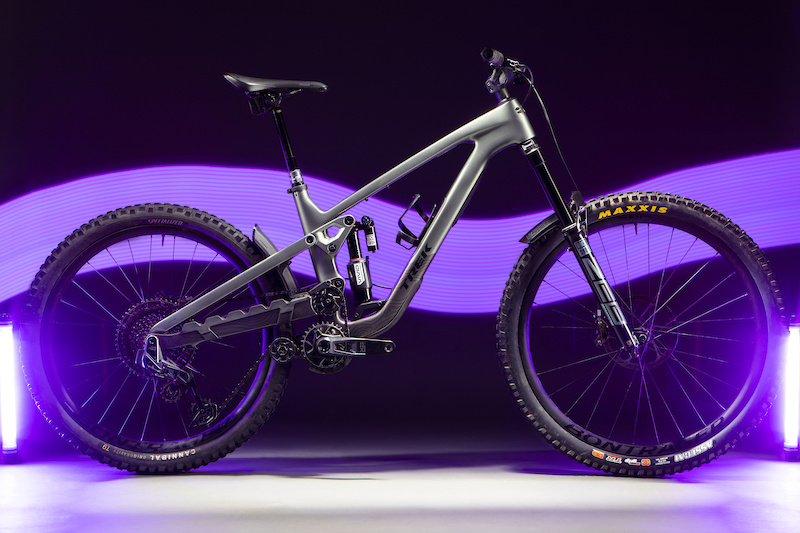Trek Slash
Words by Dario DiGiulio; photography by Tom Richards
The geometry is progressive without being extreme, the kinematic isn’t unusual or radical, and the frame still carries typical Trek lines and accessory elements. As the bike is fairly new, you can dig into the fresher tech details in our First Ride article. This all paints a pretty rosy picture, but with a truly impressive fleet of bikes at this year’s Field Test, the Slash had its work cut out for it.
• Carbon fiber frame
• Travel: 170mm / 170mm fork
• Mixed wheel or full 29″
• 63.3° head angle
• 77° seat angle
• Reach: 432, 448, 468 (test), 488 (test), 513
• Size-specific chainstays
• Weight: 36.1 lb / 16.4 kg
• Price: $9,399 USD
• trekbikes.com
In keeping with the updates made to the Fuel EX last year, the new Slash has a ton of baked-in adjustments that can be made by the end user. Press-in headset cups allow you to slack out or steepen the head tube by 1° in either direction, a replaceable lower shock mount accommodates either a 29″ or 27.5″ rear wheel, with a flip chip contained therein to switch between high and low shock progression modes. All this makes for a bike that can really transform, but for the sake of this test we kept things in the mixed wheel, 63.3° head angle stock setup.
The seat angle sits around 77°, depending on the size, with chainstay length also varying to match the front end growth. Those chainstay lengths depend on whether you’re running mixed or matching wheel sizes, but assuming the former the dimensions are as follows: S, 429mm; M, 429mm; M/L, 434mm; L, 434mm; XL, 439mm. Those might seem a bit short on paper, but it’s important to remember that due to the high pivot layout, they grow quite a bit at sag and through the travel. At sag, the wheel is about 11mm further back, and at full extension the chainstays are a full 19mm longer than the static number. With 27mm of bottom bracket drop, the center of gravity is quite planted on the Slash, adding to the cornering stability that the growing wheelbase can provide.
Both the carbon and aluminum models get well sorted in-frame storage, in addition to some top tube bottle bosses, should you want to carry all the stuff in and on your bike.
Climbing
With 170mm of travel front and rear, it’s safe to assume that climbing the Slash would be a bit of a bear, but quite a bit of work was done to make sure that it wasn’t a major chore to get up to the top of your chosen descent. With very consistent anti-squat across the entire gear range – hovering just above 100% at sag – the Slash climbs comfortably and consistently, offering enough support to ride high, while still absorbing bumps along the way.
There’s definitely some extra drivetrain noise accompanying the idler pulley and lower chain roller, but thanks to the high tooth count on that upper idler it’s not too extreme. I spent some long pedal days on the Slash, and never found myself hating the experience – it’s more than happy to motor along on logging road climbs just as it’s excited to rally up technical bits of trail.
We’ve done the monster math, and though idler bikes do appear to be a bit slower over the course of a long climb, the Slash offsets that extra drag with an even-keeled pedaling platform and good body position that keep you comfortable for the long haul.
Descending
There’s a broad assumption that the bump-eating gains of a high pivot bike are won at the cost of the overall maneuverability and pep in slower terrain. There are a few exceptions to this claim, and chief among them is the new Slash. This bike can happily mow through chunky sections of trail, but is equally capable feeling when things get tight and slow, thanks in large part to the carefully-considered geometry and very predictable suspension feel.
That predictability is key to the overall versatility of the bike, as you can push into the suspension in more flowing terrain without feeling like you’re losing too much energy to the rear end. This support ramps up nicely in the middle of the stroke, meaning the bike retains a soft top-end feel for excellent small bump performance and grip. The overall feel biases towards that latter end of the spectrum, which to me is what you’re probably after if you’re in the market for a 170mm high pivot.
Jumping feels natural and intuitive on the Slash, and though the bike might lack some of the pop of the Ibis, it still manages to feel fun and energetic on smaller side hits and natural doubles. The Trek does feel like its penchant for speed dictates some of the terrain you’ll want to point it down, as it truly comes alive when you’re pushing hard on seriously challenging trails.
As a whole package, the Slash is a stiff and precise feeling bike, perhaps too much so for some who want a more forgiving chassis. The one-piece carbon bar/stem combo plays a big role here, transmitting quite a bit of feedback compared to traditional cockpits, but the Bontrager Line 30 wheels are also rather stiff. The latter didn’t bother me, as they held their line nicely and shirked off plenty of the hard hits and corners that the bike is keen to carry out.
Trek did a very good job making the Slash a quiet bike, then seemingly lost the plot when they specced a hard rubber chainslap protector that does little to mitigate the drivetrain noise in bumpy terrain. I replaced the stock rubber with a bit of STFU tape, and found that the bike went from clattering through successive hits to performing in near silence, making the ride all the more sweet.
Technical Report
MRP MXg Chain Guide: This innocuous seeming lower roller may have proven to be the most controversial element of the new Trek, given the issues quite a few early users had with the chain dropping off the roller during fairly normal riding scenarios. I had this happen quite a few times during testing, both in the bike park and on lower speed tech trails in the area – all to some frustration.
After reaching out to Trek and MRP, it became clear that the guide had been improperly installed from factory, with 5mm instead of the intended 7mm of spacers between the frame and the guide. 2mm didn’t seem like it would make much difference to me, but after changing the spacing and taking the bike to Pemberton for a huge weekend of riding, I was unable to get the chain to drop again. The trails up there are rough, fast, and full of good chain-challenging moments, so it’s possible things are fixed for good.
RockShox Vivid Ultimate Shock: In many ways the Slash feels like the showcase bike for just how well the Vivid can perform. Its dead silent operation and excellent damping suit the bike nicely, and the shock tune feels perfect for a wide swath of riding styles. With relatively simple and visual adjustment, finding a happy place in the clickers is easy and intuitive.
RockShox AXS Reverb Seatpost: The Slash has an impressively long insertion depth, but none of that was taken advantage of in speccing an AXS post, which really only wins points in the cockpit tidiness department. Additionally, the AXS posts are prone to developing sag, which ours did within the first few days of testing. You can bleed the post fairly easily, but not having to do that in the first place would be a better proposition.

Laura Adams is a tech enthusiast residing in the UK. Her articles cover the latest technological innovations, from AI to consumer gadgets, providing readers with a glimpse into the future of technology.








